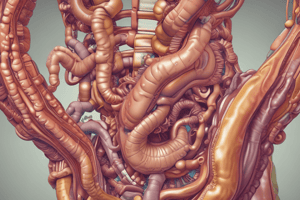Podcast
Questions and Answers
In Western countries, which part of the colon is most commonly affected by diverticulosis?
In Western countries, which part of the colon is most commonly affected by diverticulosis?
- Left colon
- Right colon
- Transverse colon
- Sigmoid colon (correct)
What is the primary role of CT-guided percutaneous drainage in diverticulitis?
What is the primary role of CT-guided percutaneous drainage in diverticulitis?
- To diagnose diverticulitis
- To drain abdominal abscesses (correct)
- To perform elective colonoscopy
- To exclude competing diagnoses
What is the diagnostic procedure of choice for acute diverticulitis?
What is the diagnostic procedure of choice for acute diverticulitis?
- Endoscopy
- Plain Films
- Computed Tomography (correct)
- Contrast Enema Examinations
When is hospitalization required for diverticulitis?
When is hospitalization required for diverticulitis?
What is the primary goal of outpatient management for mild diverticulitis?
What is the primary goal of outpatient management for mild diverticulitis?
What is the typical organism involved in diverticulitis?
What is the typical organism involved in diverticulitis?
What is the primary indication for surgical consultation in diverticulitis?
What is the primary indication for surgical consultation in diverticulitis?
What is the role of endoscopy in suspected acute diverticulitis?
What is the role of endoscopy in suspected acute diverticulitis?
What is the significance of right-sided diverticulosis in Asian countries?
What is the significance of right-sided diverticulosis in Asian countries?
What is the primary goal of colonoscopy in diverticulitis?
What is the primary goal of colonoscopy in diverticulitis?
What is the prevalence of diverticulosis in those younger than 40 years?
What is the prevalence of diverticulosis in those younger than 40 years?
Which of the following is a risk factor for diverticulosis?
Which of the following is a risk factor for diverticulosis?
In which region is diverticulosis extraordinarily rare?
In which region is diverticulosis extraordinarily rare?
What is the prevalence of diverticulosis in patients 80 years or older?
What is the prevalence of diverticulosis in patients 80 years or older?
Which of the following is a characteristic of diverticulosis?
Which of the following is a characteristic of diverticulosis?
Flashcards are hidden until you start studying
Study Notes
Diverticulosis
- Diverticulosis occurs when small, bulging pouches (diverticula) develop in the digestive tract.
Epidemiology
- Overall prevalence: 12% to 49%
- Increases with age:
- < 10% in those younger than 40 years
- > 50% to 66% of patients 80 years
- As common in men and women
- Men: higher incidence of diverticular bleeding
- Women: more episodes of obstruction or stricture
- Disease of Western civilization, extraordinarily rare in rural Africa and Asia
- Highest prevalence rates: United States, Europe, and Australia
- Increases with urbanization
Risk Factors
- Increasing age
- Dietary meat intake
- Living in Western countries (e.g., United States, Western Europe, Australia)
- Connective tissue diseases
- Decreased risk:
- High dietary fiber intake
- Living in predominantly rural Asian or African countries (e.g., Kenya, Jordan, Thailand)
Factors That Influence the Risk for Diverticulosis
- Location:
- In Western countries: left colon (90% sigmoid, 15% right-sided)
- In Asian countries: right-sided
Spectrum of Diverticulosis
- Uncomplicated diverticulosis:
- Asymptomatic diverticulosis
- Symptomatic uncomplicated diverticular disease (SUDD)
- Complicated diverticulosis:
- Diverticulitis:
- Uncomplicated diverticulitis: localized phlegmon
- Complicated diverticulitis: abscess, free perforation with peritonitis, fistula, or obstruction
- Bleeding
- Diverticulitis:
Diagnosis
- Plain films: abnormal in 30% to 50%
- Contrast enema examinations: only water-soluble contrast enemas (e.g., Gastrografin) should be used
- Computed tomography (CT):
- Diagnostic procedure of choice for acute diverticulitis
- CT criteria for diverticulitis:
- Presence of diverticula
- Pericolic infiltration of fatty tissue (fat stranding)
- Thickening of the colon wall
- Formation of abscesses
- Endoscopy:
- Avoided in suspected acute diverticulitis due to risk of perforation
- Electively performed 1-3 months after acute phase to exclude competing diagnoses, particularly neoplasia
Management
- Outpatient management:
- Mild symptoms
- No peritoneal signs
- Ability to take oral fluids
- Supportive home network
- Treatment with clear liquid diet and antibiotics
- Hospitalization:
- Elderly
- Immunosuppressed
- Severe comorbidities
- High fever / significant leukocytosis
- Bowel rest / intravenous fluid
- Broad-spectrum intravenous antibiotics
- Complicated diverticulitis:
- Abscess:
- Small pericolic abscesses: noninterventional management with broad-spectrum antibiotics and bowel rest
- Percutaneous catheter drainage: CT-guided percutaneous drainage of abdominal abscesses
- Abscess:
Studying That Suits You
Use AI to generate personalized quizzes and flashcards to suit your learning preferences.



